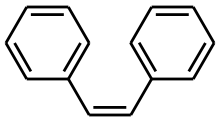(Z)-Stilbene
(Z)-Stilbene is a diarylethene, that is, a hydrocarbon consisting of a cis ethene double bond substituted with a phenyl group on both carbon atoms of the double bond. The name stilbene was derived from the Greek word stilbos, which means shining.
 | |
-Stilbene-3D-spacefill.png) | |
| Names | |
|---|---|
| IUPAC names
cis-1,2-Diphenylethylene (Z)-1,2-Diphenylethene | |
| Other names
cis-Stilbene | |
| Identifiers | |
CAS Number |
|
3D model (JSmol) |
|
| ChEBI | |
| ChEMBL | |
| ChemSpider | |
| ECHA InfoCard | 100.010.406 |
| EC Number |
|
PubChem CID |
|
| UNII | |
CompTox Dashboard (EPA) |
|
InChI
| |
SMILES
| |
| Properties | |
Chemical formula |
C14H12 |
| Molar mass | 180.250 g·mol−1 |
| Appearance | Liquid |
| Melting point | 5 to 6 °C (41 to 43 °F; 278 to 279 K) |
| Boiling point | 307 °C (585 °F; 580 K) at 1 atm (82°C to 84°C at 0.4 mmHg) |
Solubility in water |
Practically insoluble |
| Hazards | |
| Safety data sheet | Oxford MSDS |
| R-phrases (outdated) | R36 R38 |
| S-phrases (outdated) | S26 S36 |
Except where otherwise noted, data are given for materials in their standard state (at 25 °C [77 °F], 100 kPa). | |
| Infobox references | |
Isomers
Stilbene exists as two possible isomers known as (E)-stilbene and (Z)-stilbene. (Z)-Stilbene is sterically hindered and less stable because the steric interactions force the aromatic rings 43° out-of-plane and prevent conjugation.[1] (Z)-Stilbene has a melting point of 5–6 °C (41–43 °F), while (E)-stilbene melts around 125 °C (257 °F), illustrating that the two compounds are quite different.
Uses
- Stilbene is used in manufacture of dyes and optical brighteners, and also as a phosphor and a scintillator.
- Stilbene is one of the gain mediums used in dye lasers.
Properties
- Stilbene will typically have the chemistry of a diarylethene, a conjugated alkene.
- Stilbene can undergo photoisomerization under the influence of UV light.
- Stilbene can undergo stilbene photocyclization, an intramolecular reaction.
- (Z)-Stilbene can undergo electrocyclic reactions.
Natural Occurrence
Many stilbene derivatives (stilbenoids) are present naturally in plants. An example is resveratrol and its cousin, pterostilbene.
References
- Eliel, Ernest L.; Wilen, Samuel H. (1994). Stereochemistry of Organic Compounds. John Wiley and Sons. pp. 566–567. ISBN 0-471-01670-5.